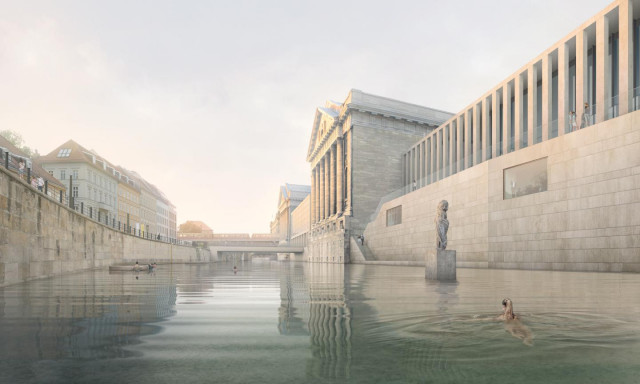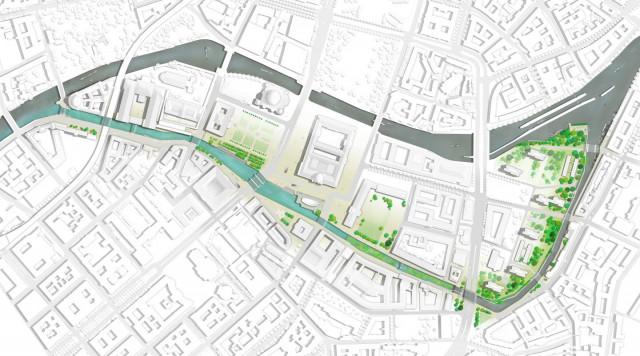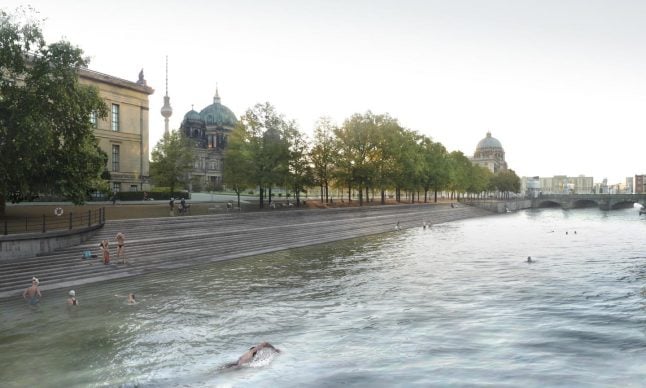At the start of July, 170 hardy individuals sprung into the waters on the Spree canal, a branch of Berlin’s main river that elbows out around Museum Island into the heart of the capital.
The water was a pleasant 20.6 degrees Celsius and several rounds of testing had shown that no one who braved the waves would die as a result.
“This year the number of participants doubled in comparison with 2016,” organizer Jan Edler said after the race. “It shows the growing public support for a project which aims to win back the Spree canal and then the whole inner city Spree as a common resource for man and nature. The foundations for this project have been laid. It is not a matter of if, but when.”
The swimmers were taking part in the fourth annual Berliner Flussbad Pokal, a race along the canal organized by Edler and a gaggle of city planners who have a vision of turning the murky Spree canal into a huge outdoor swimming area. But for that to happen, the river Berliners call the Kot (feaces) d’Azur will need to undergo a major makeover.
If Edler has his way, Berliners will one day descend elegant steps into the Spree canal, from which they can ease themselves into pristine waters cleaned by reed beds that'll give the urban waterway the appearance of verdant country creek.
But few swimmers will forget for long that they are in the middle of one of the great global capitals: on the east bank, the neoclassical columns of Museum Island will loom above them.

Cleaning up its image
Despite its reputation, the Spree isn’t actually all that dirty – at least most of the time. When the river enters the capital its waters are so clean that you can go for a dip without worrying about your health, Edler's organization, Flussbad Berlin, claims.
The problems start inside the city, or more specifically, when it starts to rain in the city. Around 15 times a year, heavy rainfall overloads the city’s 19th century “mixed” drainage system. The sewage and rainwater which normally head towards sewage facilities overflow into the river, spewing faeces, detergents and tampons into the river.
The effects are so serious that fish often die en masse in the aftermath of one of these floodings. Anyone who is foolhardy enough to swim in the Spree in the first place is advised not to enter for several days after heavy rain.
It is therefore not surprising that the EU has called on the German capital to clean up its aquatic highway.
To this end, the city is generously backing the Flussbad Berlin project with €4 million to help it realize its aim. Berlin politicians are taking the project so seriously that it was written into the coalition treaty when a new city government was formed in 2016.
The plan itself involves dividing the two kilometre canal into three sections.
At the upper canal, in the so-called Fischerinsel area, Edler and his colleagues plans are to create a “ecological regeneration zone” where flora and fauna will grow in the shallower waters.
Further down towards the Foreign Ministry building, 400 metres of reed bed will be laid. The reeds will clean the water through a natural filtration system that has become common in small scale sewage systems.
Below that a 835-metre stretch of water will emerge which is clean enough to swim in, regardless of whether there has been a downpour the day before or not. Where the canal flows back into the main river, a form of weir will be built to stop the unclean Spree water spilling up into the canal.

Bumping up against bureaucrats
The idea might sound like a no-brainer to Berliners who currently need to travel to the outer districts to find an outdoor swimming spot. But the road to completion has been far from straightforward.
When Edler and brother Tim propsed the idea in the late 1990s one critic described it as “so unrealistic that we needn't bother talking about it.”
While attitudes have slowly changed, the fact that the proposed swimming spot is surrounded by a UNESCO world heritage site has made planning tricky.
Agreeing on access points to the water has been one major sticking point. At first the plan foresaw a wide set of steps at the Lustgarten park. But this plan was nixed by the city’s Monuments Authority which raised objections including that the swimming area would lead to overcrowding in the historical 19th century park.
In order to appease the authorities, Flussbad Berlin have had to create three small entry points dotted along the swimming area from the Bode Museum to the Fischerinsel.
The next hurdle thrown up by the Monument Authority was the fact that the reed bed would prevent the grand buildings on the island from being mirrored in the water and would thus rob them of their full majesty. The planners have also had to make concessions here at the section of the canal next to the Jungfernbrücke.
While the foundation which owns the museums initially rejected the swimming spot out of hand, “they have gone from talking about if to where,” Edler said recently.
It could still be years yet though before the project becomes a reality. First Flussbad Berlin needs to carry out extensive testing to understand what type of filtration system will reliably clean up the water. And the plan still needs final approval from the city senate. Nonetheless Edler says that “the project is now realistic enough that we can all begin to dream about a clean Spree in the city centre.”



 Please whitelist us to continue reading.
Please whitelist us to continue reading.
Member comments